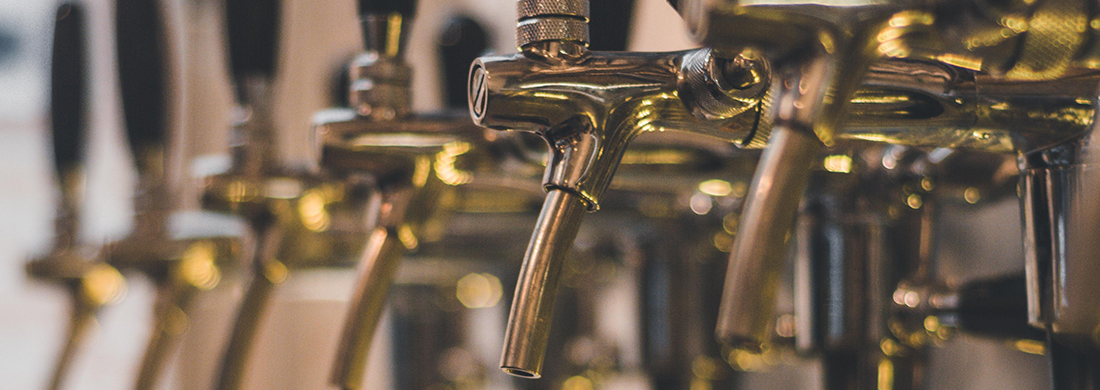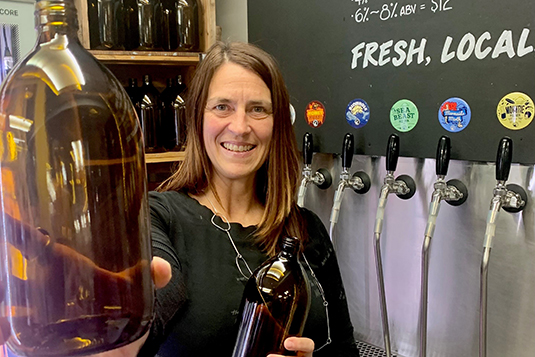
Greentech to keep beer flagons in use again and again

One of the first movers in reusable coffee cups in Aotearoa New Zealand, Again Again, is now branching out into beer. The company has pivoted to become a dedicated technology provider to enable reuse and foster behaviour change across the hospitality sector.
The Glass Packaging Forum (GPF) chatted with co-founder Nada Piatek to find out about their reusable beer flagon project, which has received funding from the Te Tahua Pūtea mō te Kirihou Auaha Plastics Innovation Fund, the Glass Packaging Forum, and Garage Project.
GPF: Tell us about the project and what you hope to achieve
Nada Piatek: Again Again is a technology platform which enables and manages the circular movement of a reusable container asset pool. We are working alongside brewers and taprooms to identify a reusable container for beer that’s hopefully able to be used all and make it available in an integrated and easy-to-use system.
We’ve learn a number of positive things through the coffee cup return schemes that we have run – some people want to, and love, being a part of the solution, but there are also some big hurdles. Many people don’t want to download an app and they don’t want to use a scan station.
Currently, you order and pay for your coffee and then you borrow your container and transact that separately, so we’ve actually doubled the amount of work at the counter and that’s no good.
The bulk of the budget for the beer project is to develop the technology to deal with the doubling up problem. So, at the end of the project we’ll have a system which can be fully integrated with point-of-sale systems.
When you are at the counter you just order your beer in a returnable bottle, and they ring it up. You won’t have to use a scan station – you just use a digital card which gets scanned for you to put the container onto your account. You can then redeem the deposit when you bring the container back.
It’s a system which could be expanded to be used for any reusable container.
GPF: That’s the main part of the project. What does the rest entail?
Nada: Again Again is consulting with industry to understand what the most desirable container format may be. Once we have narrowed it down to a few, we will do an LCA to ensure that it’s actually better for the environment before we make a final decision. That’s the second part of the project.
Part three is the deployment of the containers and getting the network set up. Again Again will buy an asset pool of those flagons. We’ll subsidise that going out to all the vendors who choose to be involved in the early stages.
Part four is a behaviour change campaign which will run for a year.
GPF: Why did you decide target the beer market?
Nada: The fact that tap rooms already exist and the people buying beer from tap rooms already understand the concept of the container and beer being separate things, means that industry is a great place to start.
It’s an industry where there is a willingness by the producers, retailers and customers to explore the concept, which is super important because this isn’t an easy change to make.
We also already had an established relationship with Garage Project and other brewing businesses, and they were keen to support.
GPF: Where do you hope to see this technology going in the future?
Nada: Upstream, a reuse organisation in the United States forecast that by 2030, 30% of all packaging will be reusable containers. The European Union parliament has set targets of 10% in the same time frame.
The gold standard will be as a consumer I get my product off the shelf in the supermarket, at the counter the cashier scans it and you can then transfer the responsibility of that packaging onto your Again Again account with a card and it’s your job to return it.
The benefit of our system is it can be available to consumers using reusable packaging without them having to think about it or do any preplanning other than setting up an account with us.
GPF: Why did Again Again decide to pivot into tech?
Nada: When the pandemic arrived it gave us the space to look at how we could step into the part of the market which isn’t served by a deposit return. We did fundraising and built an MVP (minimum viable product) which we deployed last year with Havana Coffee Works at 75 locations around the country. Havana provided coffee cups into those cafes and use our technology to manage them.
The uptake in usage is still minimal, but what we’ve learned is the people who want to use it really want to use it. Also, the brands are happy with the opportunity to brand it themselves and not have our brand forced on them. Importantly it’s commercially viable – the numbers stack up and it actually creates a revenue stream. So, we have validated all those commercial requirements.
GPF: How does your system differ from a deposit return model?
Nada: In our coffee cup system we have a 98% return rate, which is incredible. The ‘threat’ of the future payment is enough to incentivise people to return their containers, and we have a good system of reminding them to return their container.
This is where tech wins over a deposit return model, for reuse, because with a deposit return the cost is sunk up front and then it’s no skin off your nose if you don’t get it back. As a result, the return rate in deposit return models tends to sit down around 75%, which means around one in four containers doesn’t come back. Only getting four uses from a container isn’t better for the environment.
It would be wrong to bring in a system which isn’t better for the environment, so that’s where the return rate is pivotal.
What you need is a 95% return rate, which equates to 20 uses, which is about your carbon break-even point. It needs to be higher still to really reduce the investment that the producers have to put into the asset pool, and that’s were technology wins over a cash deposit.
GPF: Where do you see Again Again going in the future?
Nada: We are still container owners, but really they are most important as a proof of concept. We are a technology company now and see this is the future of reusable packaging systems. The two business units already run separately, and there will be a point in the future where those two parts of the business separate, and we sell off the container part and keep going with the tech.
This is a hotly contested industry. I see us as a background player for other companies, enabling their change.
We are looking at overseas markets. The legislative environment in Europe particularly is far more ripe for the scale of our business. There are well established players in Europe, but we are unique in a number of respects which will make us more appealing.
We are super appreciative for the support of the Government and the Glass Packaging Forum, and other stakeholders. I feel confident we can deliver this project really well.
I also feel as excited about where our innovation can position us in order to export that to legislative environments which are ripe for behaviour change. We will hone them over there and be ready to roll when New Zealand is ready for it at scale.


